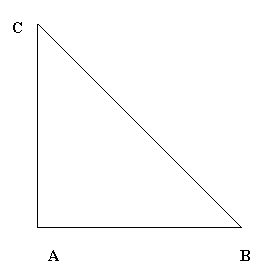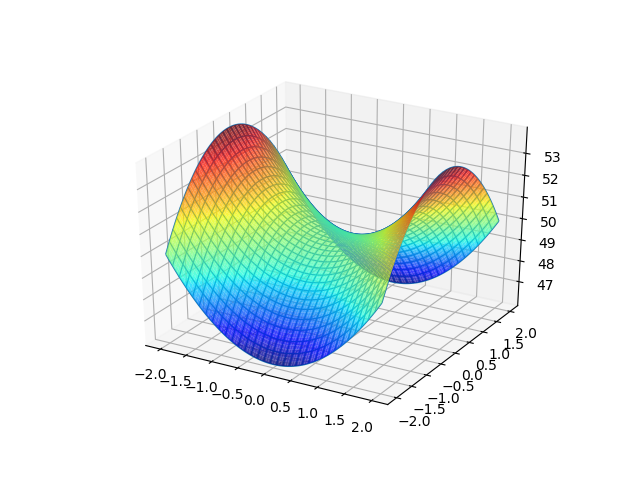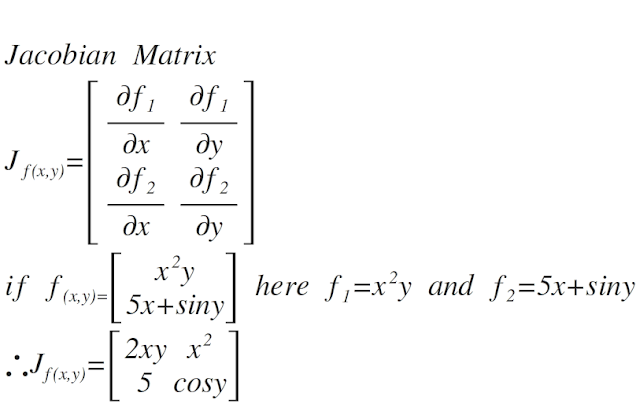Plus1 Numericals Chapter1
1.1)A star is observed from two stations on earth seperated by 10km and it's angular diameter is 2′ find the distance of the star from the centre of the earth?
Distance covered =30+50=80 km
but displacement is only 40 Km
2.2) A stone is thrown vertically up with a velocity of 19.6m/sec find the maximum height reached and time to reach the ground?(g=9.8m/sec)
u=19.6m/sec
v=0 (at max height the final velocity is zero)
v=u-gt(thrown up ie against gravity)
0=19.6-9.8×t
. . . t=2 sec
since time of flight of upward journey=time of flight of downward journey
time to reach the ground =2 ×2sec=4 sec
Let the Max height=h
S=ut + ½ at2
h=0- ½g × t2
h=9.8 × 2
h=9.8 × 2=19.6 m
. . . Maximun height reached=19.6 m
2.3) If the position time relations is given by the expression x(t)=2t3+ 5t2 then find the velocity and accelaration at t=2 sec also comment is the velocity of the particle zero at any instant
velocit v =dx/dt
v=d(2t3+ 5t2)/dt
2.4) Show that the average speed of a body which covers first half of distance with speed v1 and second half with a speed of v2 is given by the relation 2v1v2/(v1+ v2)
3.2) Derive a relation between Horizontal range and Time of flight during a projectile motion
4.2) A body of mass 5 kg is acted upon by two pe
rpendicular forces 8 N and 6 N. Give the magnitude and direction of the accelaration
The net force is given by W+ma if the lift is moving up with an accelaration a and W-ma if the lift is moving down with an accelaration a
in case 1 a=0 . . . Net force= W=70×10+70x0=700 N ie the reading on the scale remains the same ie 70 kg
in case 2 a=5 m/ sec2 . . . Net force= W=70×10+70x5=1050 N the reading on the scale=105 kg
in case 3 a=5 m/ sec2 . . . Net force= W=70×10-70×5=350 N the reading on the scale=35 kg
in case 4 a=g=10 m/ sec2 (free fall) . . . Net force= W=70×10-70×10=0 N the reading on the scale=0 kg
Since the strings are connected the magnitude of accelaration and tensions in the strings for the two masses will be the same and is a and T
At equilibrium (on M)
tan1′=EB/EC
. . . EC=5000 / tan1′=95405.68m=954.06 Km
1.2) In an experiment the mass of an iron ball in five successive measures are given by 3.51 gm,3.52 gm,3.49 gm, 3.54 gm,3.53 gm calculate a) the mean value of the mass of balls b) the absolute error in each measurement c) mean absolute error d) relative error e) percentage error
a) Mmean=(3.51+3.52+3.49+3.54+3.53) / 5
Mmean= 3.518=3.52 gm
b) the absolute error
∆m1=Mmean-m1 and so on up to 5 measurements
3.52-3.51=0.01
3.52-3.52=0.00
3.52-3.49=0.03
3.52-3.54=0.02
3.52-3.53=0.01
c) Mean absoute error=(0.01+0.00+0.03+0.02+0.01) / 5
Mean absoute error= ∆mmean=0.014
relative error= 0.003977
e) percentage error=relative error x 100=0.003977× 100=0.3977%
1.3) Write down the number of significant figures in the following.
a) 2 b) 3 (CLICK HERE FOR PHYSICS NOTES for details)
1.4) If the resistance of a wire is measured to be 100+ 2 ohm and its current is measured to be 10 + 0.3 A find the relative and percentage error in Voltage(V)
We know that V=IR
ie ∆V/V=∆R/R + ∆I/I
∆V/V=2/100+0.3/10=5/100=0.05
V=IR=100×10=1000
∆V=V×0.05
∆V=1000×0.05=50
The correct value of V lies between V + ∆V
ie 1000 + 50 Volt
from this percentage error on V is ( ∆V/V) × 100=(50/1000) × 100=5%
Alternatively
Percentage error on V= percentage error on R + percentage error on I (since the product)
Percentage error on V=(2/100) ×100 + (0.3/10) ×100=2+3=5%
1.5) Find the dimension of a / b if F=(a-x2) / bt , where the dimension of F is that of force and x that of length and t that of time
F=[a/(bt)]-[ x2 / bt]
. . . the dimension of a / (bt) should be that of force
ie DO F=DO a/(bt)
. . . DO of a/b = DO F × DO t
= M1L1T-2 × T1
= M1L1T-1
. . . DO of a/b= M1L1T-1
2.1) A car starts from A and covers a distance of 30 km and reaches B and then covers a distance of 50 km and reaches C find the distance covered and displacement of the car at the end of the journey?

Here AB=30 km and BC=50 km
By Pythagores theorem 
Here AB=30 km and BC=50 km
AC=√(BC2-AB2)
AC=40 kmDistance covered =30+50=80 km
but displacement is only 40 Km
2.2) A stone is thrown vertically up with a velocity of 19.6m/sec find the maximum height reached and time to reach the ground?(g=9.8m/sec)
u=19.6m/sec
v=0 (at max height the final velocity is zero)
v=u-gt(thrown up ie against gravity)
0=19.6-9.8×t
. . . t=2 sec
since time of flight of upward journey=time of flight of downward journey
time to reach the ground =2 ×2sec=4 sec
Let the Max height=h
S=ut + ½ at2
h=0- ½g × t2
h=9.8 × 2
h=9.8 × 2=19.6 m
. . . Maximun height reached=19.6 m
2.3) If the position time relations is given by the expression x(t)=2t3+ 5t2 then find the velocity and accelaration at t=2 sec also comment is the velocity of the particle zero at any instant
velocit v =dx/dt
v=d(2t3+ 5t2)/dt
v=6t2+10t
Velocity at t=2 sec
v=6×4+10×2
velocity=24+20=44 units
accelaration=d2x/dt2=dv/dt
= 12 × t+10
at t=2 sec
accelaration=24+10=34 units
If velocity=0 then
6t2+10t=0
ie t(6t+10)=0
ie at t=0 or 6t+10=0
6t=-10
t=-10/6
Since time can not be negative . . . velocity is zero at t=0 ie at the start only
average speed= total distance covered / total time taken
let the total distance be 2x
then time to cover the first half= x/ v1
then time to cover the second half= x/ v2
average speed= 2x /[(x/ v1)+(x/ v2)]
=2 v1 v2 / (v1+ v2) ( you can use this formula while solving problems)
3.1) Rain is falling vertically with a speed of 30m/sec. A woman rides a bicycle with a speed of 10m/sec in north to south direction. What is the direction in which she should hold her umbrella from the vertical?
Let the velocity of the woman is P and velocity of rain is Q
Let the velocity of the woman is P and velocity of rain is Q
here CA is in the direction of Q and AB is in the direction P and CB is the direction in which the woman has to hold the umbrella from the vertical
By triangle law CB is the resultant of P and Q by finding the angle ACE( angle made from vertical)we can solve this problem
angle ACE= tan-1Q/P = tan-1(10/30) = 18026'
3.2) Derive a relation between Horizontal range and Time of flight during a projectile motion
R=u2 sin2θ/g............(1)
T=2usinθ/g.............(2)
Dividing (1) by (2)
R/T= (u2 sin2θ/g) / 2usinθ/g
=ucosθ
. . . R=T ucosθ
R=T× Horizontal component of velocity
This shows that the horizontal component remains the same during the motion.
3.3) Find the resultant of two vectors which have same magnitude and inclined with each other at an angle of 1200
By parallelogrma law resultant R= √(P2+Q2 +2PQcosθ)
Here P=Q and θ=1200
. . .R=√(P2+P2 +2P2cos120) =√(2P2 +2P2cos120)=√(2P2 +2P2(-1/2))=P
ie the resultnat is equal to one of the forces
angle of resultant from the vector P is given by tan-1[Q sinθ/(P+Q cosθ)]= tan-1[Psin120/(P+P cos120)]= tan-1 √3=600
The resultant is one of the vectors and inclined at an angle of 600
4.1) In the following figure a mass of 6kg is suspended by a rope from a ceiling. A force of 50N in the horizontal is applied
at the point P . What is the angle the rope made with vertical at equilibrium? (g=10 m/sec2)
The 3 forces acting at P are T2,T1,and 50N
But from the figure; at equilibrium T2=T1cosθ
ie 6kg=60N=T1cosθ....................(1)
50N=T1Sinθ........................(2)
dividing eqn (2) by (1)
. . . tanθ=5/6
. . . θ= 400
4.2) A body of mass 5 kg is acted upon by two pe
rpendicular forces 8 N and 6 N. Give the magnitude and direction of the accelaration
of the body.
Since two forces at right angles then its resultant is √(82+62)=10 N (CLICK HERE FOR chapter 3 PHYSICS NOTES )
accelaration= F/ m ie 10/5=2 m/sec2
tanθ=6/8=3/4
. . . θ= 370 from the 8 N force
4.3) A truck starts from rest and accelarates uniformly at 2 m/sec2.At t=10 sec, a stone is dropped by aperson standing on the top of the
truck 6 m heigh from the ground. What are the velocity and accelaration of the stone at t=11 sec?
At t=10 sec velocity of the truck=a×t (since u=0)
=2×10=20 m/sec horizontally
so the horizontal velocity of stone at this time is same ie 20 m/sec
and it is same throughout the motion for the stone ie at t=11 sec also
But while the stone is dropping freely the vertical component of velocity at 11 sec is
vertical component is 10 m/sec and horizontal component is 20 m/sec at t=11 sec
The resultant is √(202+102)=√(500)=22.4 m/sec
and the accelaration at t=11 sec will be accelaration due to gravity=10 m/sec.
4.4) A man of mass 70 kg stands on a weighing machine in a lift which is moving
- upwards with uniform speed of 5 m/sec
- downwards with a uniform accelaration of 5 m/ sec2
- upward with a uniform accelaration of 5 m /sec2
- if the lift failed and falls down freely
The net force is given by W+ma if the lift is moving up with an accelaration a and W-ma if the lift is moving down with an accelaration a
in case 1 a=0 . . . Net force= W=70×10+70x0=700 N ie the reading on the scale remains the same ie 70 kg
in case 2 a=5 m/ sec2 . . . Net force= W=70×10+70x5=1050 N the reading on the scale=105 kg
in case 3 a=5 m/ sec2 . . . Net force= W=70×10-70×5=350 N the reading on the scale=35 kg
in case 4 a=g=10 m/ sec2 (free fall) . . . Net force= W=70×10-70×10=0 N the reading on the scale=0 kg
4.5) Two masses 8 kg and 12 kg are connected at the two ends of a light inextensible string that goes
over a frictionless pulley. Find the accelaration of the masses and the tension in the string when the
masses are released.
Since the strings are connected the magnitude of accelaration and tensions in the strings for the two masses will be the same and is a and T
Net force acting on 12 kg mass=(12 ×g)-T=12 × a ......................(1)
Net force acting on 8 kg mass=T- 8 × g =8 × a ............................(2)
12 × g-12 × a=8 × a+8 × g
. . .20a =4g=40
. . .a=2 m/ sec2
sub in eqn(1) for a=2
T=120-24=96 N
4.6) What is the accelaration of the block and trolley system as shown if the coeficient of kinetic friction is 0.04 between trolley
and surface also calculate tension (T)in the string if M=20 kg and m=3 kg (take g=10 m/sec2 )
At equilibrium (on M)
Mg=N
T- fs=Ma
but fs=μsN
. . .T=Ma+μsN
T=Ma+μsMg..................................(1)
At equilibrium (on m)
mg-T=ma
. . .T=mg-ma....................................(2)
comparing eqn (1) and (2)
20a+0.04 × 20 × 10= 3 × 10 -3a
23a=22
. . .a=22/23=0.96 m/sec2
substituting value of a in eqn(2)
T=3×10-3×0.96=27.1 N
. . . Tension in the string is 27.1 N and accelaration of the system is 0.96 m/sec2
4.7) Two billiard balls each of mass 0.05 kg moving in opposite directions with speed 6 m/sec colllide and rebound with the same
speed. What is the impulse imparted to each ball due to the other?
m1=m2=0.05 kg
u1=6 m/sec
u2=-6 m/sec
v1=-6 m/sec (since after collision they move in opposite directon)
v2=6 m/sec
Change in momentum of 1st body is m1v1-m1u1=0.05×6-0.05×(-6)=2×0.05×6=0.6 kg m/sec
but change in momentum is impulse
. . .impulse=0.6 kg m/sec
4.8) A stone of mass 0.25 kg tied to the end of a string is whirled round a circle of radius 1.5 m with a speed of 40 rev / min
in a horizontal plane. What is the tension in the string? What is the maximum speed with which the stone can be whirled if
the string can withstand a maximum tension of 200 N?
Tension = centripetal force (at equilibrium)
T=mv2 / r
bur v=rω
ω=2π / Time period=2πυ (υ=1/Time period )
υ=40 / 60 =4/6
. . .v=r×2π×4/6
v=1.5× 4× 2π/6=2π
T=0.25×6.182/ 1.5=6.6 N
Tension in the string is 6.6 N
ii)
velocity=√(rT/m)=√1.5×200/0.25=34.64 m/sec
the safe velocity without the breakage of the string is 34.64 m/sec
5.) If the force F can be expressed as a function of x by the following function F(x)=x2 find the work done in moving
this object from x=2units to x=5 units ?
we know that the work done by a variable force is given by ∫ab F(x) dx
ie ∫25 F(x) dx
W=∫25 x2dx (note that ∫ xn dx=x(n+1)/(n+1))
W=[x3/3]25=(125-8) / 3=117 / 3 units=39 units







Notes will be updated soon.
ReplyDelete